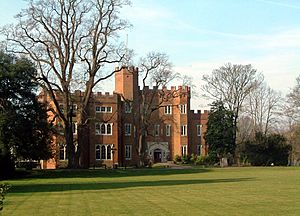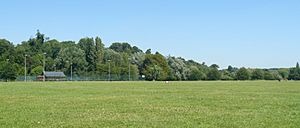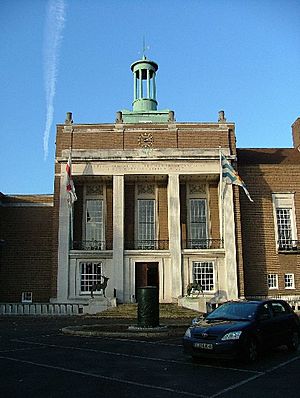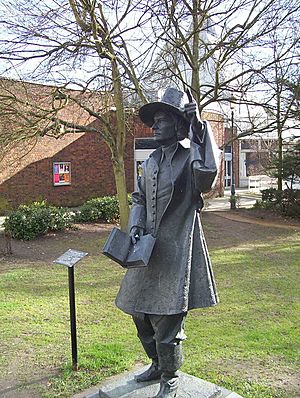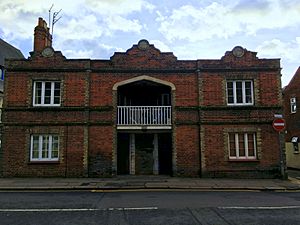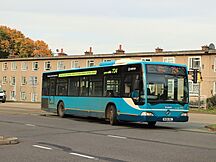Hertford facts for kids
Quick facts for kids Hertford |
|
|---|---|
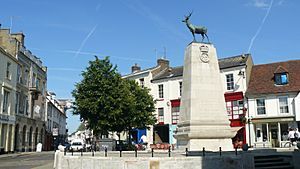 Parliament Square, Hertford Town Centre |
|
| Population | 26,783 (2011 Census, parish) |
| OS grid reference | TL325125 |
| • London | 19.2 mi (30.9 km) S |
| Civil parish |
|
| District |
|
| Shire county | |
| Region | |
| Country | England |
| Sovereign state | United Kingdom |
| Post town | HERTFORD |
| Postcode district | SG13, SG14 |
| Dialling code | 01992 |
| Police | Hertfordshire |
| Fire | Hertfordshire |
| Ambulance | East of England |
| EU Parliament | East of England |
| UK Parliament |
|
| Website | www.hertford.gov.uk |
Hertford is a historic town in England. It is the county town of Hertfordshire, which means it's the main town where the county's government is located. In 2011, about 26,783 people lived here.
The town started growing around a place where people could cross the River Lea. This spot was special because other rivers like the Mimram, Beane, and Rib also joined the Lea nearby. You can even travel by boat from the River Thames all the way to Hertford!
Around 913 AD, people built strong forts on both sides of the river crossing. The county of Hertfordshire was also created around this time and named after Hertford. Later, Hertford Castle was built after the Norman Conquest in 1066. It was a home for kings and queens until the 1600s.
Today, Hertford is still an important place. Both the Hertfordshire County Council and East Hertfordshire District Council have their main offices here. These councils are big employers in the town. McMullen's Brewery, a company that makes beer, has also been in Hertford since 1827. Many people who live in Hertford also travel to London for work, as the city is only about 20 miles (32 km) away by train.
Contents
- What Does the Name Hertford Mean?
- Hertford's Past: A Look at History
- How Hertford is Governed
- Hertford's Location and Surroundings
- Hertford's Economy: How People Work and Shop
- Sports and Fun in Hertford
- Famous People from Hertford
- Important Places and Buildings (Landmarks)
- Getting Around: Transport in Hertford
- Learning in Hertford: Schools and Education
- Media and Entertainment
- Town Twinning
- Images for kids
- See also
What Does the Name Hertford Mean?
The name Hertford is very old! The first time we see it written down was in 731 AD. A writer named Bede called the town Herutford.
The word Herut is an Old English word for a hart, which is a fully grown male deer. So, the name Hertford means "a place where harts (deer) cross the river." In 1086, the Domesday Book spelled it as Hertforde.
Hertford's Past: A Look at History
Hertford has a long and interesting history. Some people think the town was mentioned even earlier, in 672 AD. This was when an important meeting of bishops from England, called a synod, took place. They met either in Hertford or a nearby place called Hartford, Cambridgeshire.
In 913 AD, Edward the Elder, an Anglo-Saxon king, ordered two special forts called burhs to be built. These forts were made of earth and helped protect the town from the Danes.
By the time the Domesday Book was written in 1086, Hertford had two churches, two markets, and three mills. After the Normans took over England, they started building Hertford Castle. A religious house called Hertford Priory was also founded.
King Henry II later rebuilt the castle using strong stone. However, in 1216, during a war, Prince Louis of France attacked and captured the castle after 25 days. English royalty often visited the castle. In 1358, Queen Isabella, wife of Edward II, even passed away there.
The priory was later closed down in 1536. In 1563, something unusual happened: the Parliament of England had to meet at Hertford Castle. This was because a serious illness called the plague was spreading in London.
Hertford continued to grow as a market town and the county town. Getting around became easier when the Lea Navigation Canal was built in 1767. The railway arrived in 1843, connecting Hertford to more places.
Did you know that Hartford, Connecticut in the United States is named after Hertford, England?
How Hertford is Governed
Hertford has three levels of local government that help run the town:
- Hertford Town Council: This is the local council for the town itself.
- East Hertfordshire District Council: This council looks after a larger area that includes Hertford.
- Hertfordshire County Council: This is the biggest council and manages services for the whole county of Hertfordshire.
All three of these councils have their main offices right here in Hertford.
| Hertford | |
| Geography | |
| HQ | Hertford |
| History | |
| Created | c. 913 (Ancient borough) 1 January 1836 (Municipal borough) |
| Abolished | 31 March 1974 |
| Succeeded by | East Hertfordshire |
| Demography | |
|---|---|
| 1901 population | 9,322 |
| 1971 population | 19,540 |
Hertford has been the main town of Hertfordshire since Saxon times. In the past, the town was managed by royal officials called reeves. Later, people elected a bailiff. In 1605, the bailiff's title changed to mayor.
In 1835, Hertford became a Municipal Borough. This meant that local people could elect councillors to help run the town.
The Hertford Town Council is now based at the old gatehouse of Hertford Castle. The Hertfordshire County Council has its main office at County Hall, which was built in 1939. The East Hertfordshire District Council offices are nearby at Wallfields.
Hertford's Coat of Arms
Hertford has its own special coat of arms. Since at least 1634, the town has used a shield showing a hart (deer) standing in water. This design helps remind everyone of the town's name, which means "ford where harts are found."
In 1925, the town was allowed to add a badge to its arms. In 1937, supporters (figures on either side of the shield) were added. Today, the Hertford Town Council uses this coat of arms.
|
Hertford's Location and Surroundings
Hertford is located where four river valleys meet. The Rib, Beane, and Mimram all join the River Lea here. From Hertford, the Lea flows east and then south towards the Thames.
A large park area called Hartham Common is located where the Lea and Beane rivers meet. This park runs towards Ware and is a great place for outdoor activities.
The town centre of Hertford still has its old medieval layout. You can find many buildings with wooden frames hidden behind newer fronts, especially on St Andrew Street. Even though there's a bypass road (the A414) built in the 1960s, Hertford can still get busy with traffic.
Despite being only about 19.2 miles (30.9 km) north of Central London, Hertford feels like a charming country town. This is partly because bigger, more modern towns like Harlow, Bishop's Stortford, and Stevenage have taken on much of the new development.
|
Areas within Hertford
|
Nearby Villages
|
Hertford's Economy: How People Work and Shop
Many people in Hertford work for the local councils at County Hall (Hertfordshire County Council) and Wallfields (East Hertfordshire District Council). McMullens Brewery, a family-owned company that makes beer, is also a big employer.
A lot of Hertford residents travel to London for their jobs.
Hertford is a bit different from other nearby towns because it doesn't have a big modern shopping mall. However, you can find most of the usual supermarkets here. There's a Tesco store and a Sainsbury's that opened in 2012.
The town is known for having many independent shops, like boutiques and salons, instead of just big chain stores. This makes Hertford feel unique!
Sports and Fun in Hertford
Hertford offers many ways to stay active and have fun. There's a leisure centre with a swimming pool, a skatepark, a bowling green, and tennis courts on Hartham Common.
Football
Hertford has its own football club called Hertford Town F.C., which plays at Hertingfordbury Park. There are also youth football clubs like Hertford Town Youth FC and Bengeo Tigers Football Club, which help young players develop their skills.
Cricket
The Hertford Cricket Club has been around since 1860, though records show cricket being played in Hertford even earlier, in 1825. The club plays its matches at Balls Park and has five teams that compete in the local league.
Famous People from Hertford
Hertford has been home to many interesting people:
- Frederick Scott Archer (1813–1857), who was born in Hertford, invented an important early photography process called the collodion process.
- The famous rock band Deep Purple formed in Hertford in 1968.
- Alfred Russel Wallace, who developed a theory of natural selection similar to Charles Darwin's, lived in Hertford as a child and went to Hertford Grammar School.
- John Wilkes, a well-known politician, also studied in Hertford.
- Sergeant Alfred Alexander Burt, a soldier from Hertford, was awarded the Victoria Cross for his bravery in 1915 during a battle.
- Captain W E Johns, who wrote the popular Biggles adventure books, was born in Bengeo, went to Hertford Grammar School, and lived in Hertford.
- Samuel Stone, a Puritan minister, helped establish the American town of Hartford, Connecticut. He lived in Hertford and was baptised at All Saints Church. There's a statue of him near the Hertford Theatre.
- Jane Wenham was accused of witchcraft in Hertford in 1712. She was found guilty, but the judge helped her receive a Royal Pardon. This was one of the last witchcraft trials in England.
- Jack Trevor Story, an author, was born in Hertford in 1917.
- Television and radio reporter Tom Heap was born in Hertford.
- Actor Rupert Grint, famous for playing Ron Weasley in the Harry Potter films, lived in Hertford when he started filming. He attended Richard Hale School.
- Singer Dani Filth was born in Hertford.
- Singer George Ezra was born and grew up in Hertford, attending Simon Balle School.
- International rugby players Robbie Morris and Jamie George are from Hertford.
- Cricketers Stuart Cradock, John Hughes, and Lawrence Wright were born here.
- Eric Heffer, a Member of Parliament, was born in Hertford in 1922.
Important Places and Buildings (Landmarks)
- You can still see parts of the original Hertford Castle, including a large mound called a motte. The castle's gatehouse, which was rebuilt in 1463, is now home to the Hertford Town Council.
- There are several churches in Hertford. All Saints' and St Andrew's churches were built in the 1800s, but they stand on much older church sites. In the area of Bengeo, you can find St Leonard's, a very old Norman church with interesting architecture.
- On Railway Street, you'll find the oldest building specifically built for Quaker meetings in the world. It has been used since 1670.
- The main square in town is called Parliament Square. It's named this because the Parliament of England met at Hertford Castle in 1563 when there was a serious illness in London.
- The house where Alfred Russel Wallace lived, now called Wallace House, is at 11 St. Andrew Street and has a special plaque.
- The Shire Hall, built in 1779, was designed by a famous architect named Robert Adam. It has courtrooms on the ground floor.
- The Corn Exchange building, once a jail, is now a place for live shows and entertainment.
- The Egyptian House on Fore Street, built around 1824, looks like an ancient Egyptian building. It used to be a grocery store and is now a restaurant.
- In Cowbridge, you can see a Prince Albert Cottage. These cottages were designed to be good homes for working-class families, and Prince Albert himself was involved in their creation.
- Hertford Museum is located in a historic 17th-century house. It has a beautiful garden designed in the Jacobean style.
- A stained-glass window in St Andrew's Church is part of a theory that connects Hertford to the Knights Templar and the Holy Grail.
Getting Around: Transport in Hertford
Trains
Hertford has two train stations: Hertford East and Hertford North. You can use Transport for London Oyster cards to pay for your journey at both stations.
Hertford East Station
Hertford East is the end of the Hertford East Branch Line. Trains from here, run by Greater Anglia, go to London Liverpool Street in the City of London.
This line also connects Hertford to towns like Ware, Broxbourne, and Cheshunt. From Broxbourne, you can catch trains north towards Bishop's Stortford and Cambridge.
Hertford North Station
Hertford North is on the Hertford Loop Line, which is part of the main East Coast Main Line.
Trains from Hertford North, run by Great Northern, go north towards Watton-at-Stone and Stevenage. Southbound trains go to London Moorgate in the City, passing through areas like Enfield Chase and Finsbury Park. Some trains also go to London King's Cross.
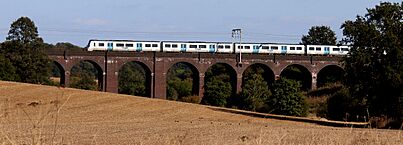
From Stevenage, you can travel further north to places like Peterborough and even Scotland. South of Finsbury Park, trains can take you to London St Pancras, Gatwick Airport, and Brighton.
Roads
The A10 runs north-south through the east side of Hertford. The Kingsmead Viaduct carries the A10 over the River Lea. Southbound, the A10 leads to the M25 motorway and London. Northbound, it goes towards King's Lynn in Norfolk.
The A414 runs east-west through Hertford. Eastbound, it goes towards Harlow and Chelmsford. Westbound, it leads to Hatfield and St Albans.
The A119 connects Hertford to Ware and goes north towards Watton-at-Stone and Stevenage.
Buses and Coaches
Hertford Bus Station is in the town centre. You can catch long-distance coaches like the 724, which goes to Heathrow Airport, or the 737, which travels to Stansted Airport or Oxford.
Local bus routes, managed by Hertfordshire County Council, connect different parts of Hertford and nearby towns. These include routes like the 308/380 to Cuffley, the 310 to Waltham Cross, and the 351 to Bishop's Stortford.
Cycling
National Cycle Route 61 passes through Hertford. The part of this route between Welwyn Garden City and Ware is also known as Cole Green Way. This route stretches from Taplow in Berkshire to near Hoddesdon.
Hertford is also the starting point for the towpath along the Lee Navigation. This path, which is part of NCR61, goes all the way to Limehouse in East London, passing through many towns and areas along the way.
River Travel
Hertford is the northernmost point where the River Lea can be used by boats. The river is managed by the Canal and River Trust. You can travel south on the river towards Bromley-by-Bow in East London. The River Lea also connects to the River Stort, which goes north through Harlow and Bishop's Stortford.
The Lee and Stort Boat Company offers boat trips between Hertford and Ware at different times of the year.
Learning in Hertford: Schools and Education
Hertford has several secondary schools for older students: the Sele School, Richard Hale School, and Simon Balle All-through School. Simon Balle also has a primary section.
Other primary schools in Hertford include Hollybush JMI, Millmead Community School, Bengeo Primary School, Morgans Primary School and Nursery, Abel Smith School, St Andrew's School, St. Josephs RC School, and Wheatcroft School.
There are also private schools nearby, such as St. Joseph's in the Park and Duncombe School. Haileybury College is a larger independent school in Hertford Heath.
For students with special needs, Pinewood and Middleton Schools are located in nearby Ware.
Media and Entertainment
Hertford is covered by BBC London and ITV London for television. You can listen to local radio stations like BBC Three Counties Radio and Heart Hertfordshire. The local newspaper is the Hertfordshire Mercury.
The Hertford Theatre, also known as Castle Hall, is a modern place for shows, movies, and art exhibitions. The Hertford Corn Exchange also hosts comedy nights and art displays.
Hertford has many places to eat, drink, and have fun, and these have become very popular. People from nearby towns and even North London often visit. There are about 25 pubs and clubs, and around 35 restaurants and takeaways.
Besides the theatre and Corn Exchange, Hertford also has a public swimming pool, gym, and a small skatepark on Hartham Common.
Town Twinning
Hertford is twinned with three other towns around the world. This means they have special friendly relationships and often exchange visits to learn about each other's cultures.
- Évron, France
- Wildeshausen, Germany
- Hartford, Connecticut, United States
Images for kids
See also
 In Spanish: Hertford para niños
In Spanish: Hertford para niños



